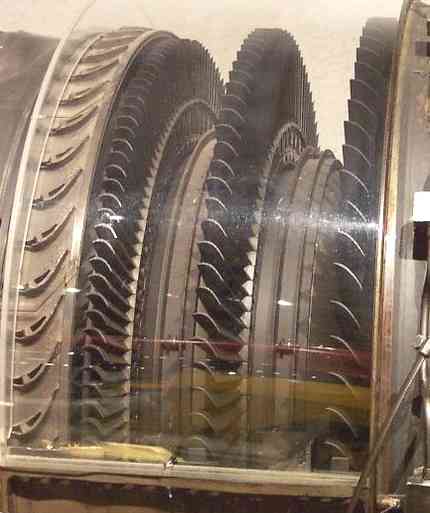Results 1 to 10 of 32
Thread: Turbine Blades
-
04-04-2009, 07:04 AM #1
 Turbine Blades
Turbine Blades
It has come to my attention recently that gas turbine engines put a lot of stress on their blades. I hear that these blades are pretty tough and that they use a special process to make them. Has anybody ever worked with that steel before? Is it suitable for making knives or razors? Also, is there a good source for free time temp transformation tables? AKA isothermic tables?
Last edited by crazycliff200843; 04-05-2009 at 02:15 AM.
-
04-04-2009, 09:07 AM #2

yes a friend of mine has a hunting knife made out of this steel it will get sharp but not that sharp , i dont think that it would be a good razor , not for shure though try it on one and see how it comes out.
-
04-05-2009, 02:16 AM #3

Where did he get it from? An airplane junk yard?
-
04-05-2009, 10:41 AM #4

I am not sure but I thought that turbine blades were made out of an Aluminum Alloy. If this is the case I don't think they would make good razors.
bjDon't go to the light. bj
-
04-05-2009, 11:16 AM #5

Some of them might be made out of aluminum, but it would make more sense to make them out of steel. But I'm not sure the process they use to 'grow' the blades would lend itself to working it into a different shape. I am also not sure that the mix used to make the steel would make for a good edge.
-
04-05-2009, 01:49 PM #6"My words are of iron..."


- Join Date
- Oct 2006
- Posts
- 1,898
Thanked: 995
The original influence on the use of ATS-34 and 154CM were as steels that would handle the higher temperatures needed in aircraft turbine engines. They make fine blades.
Terry Knipshield has been working up some razors of CPM154 that are very nice. If the turbine blades are steel, they are likely something very similar. But, without engineering specs or some analysis of the material, you can't be sure.“Nothing discloses real character like the use of power. Most people can bear adversity. But if you wish to know what a man really is, give him power.” R.G.Ingersoll
-
04-06-2009, 12:58 PM #7

I'll chime in here as I work for Pratt & Whitney as an inspector. I believe that these would not make good razors. In understanding the different sections of the engine: 1) anything from the hot section of the engine, the high and low turbine sections have cast blades with extreme curves and are usually hollow on the inside and woul break quite easily when you try to work them. 2) The foward section of the engine which is the cold section only has a couple of stages that might be used. Anything from the high compressor is too small to use for a blade as these airfoils range from a couple of inches in length to under an inch. The low compressor has a couple of stages of blades that might be used as they are bigger and longer but they still have quite a curve to them. most of these blades are stamped and then have some machine work done to them. If you could find a fan blade that might also be used as they are quite large but once again sometimes these blades are hollow to. The metal on these blades is quite hard, I'm not an engineer so I do'nt know the exact combo of metals they use. No they don't use aluminum for these blades. I have to blend and polish blades at times to remove minor damage (nicks and scratches) and this is no easy task as to the hardness of them. If you were to find one suitable enough to make into a razor I think that you will find that getting it thin enough and not having it break due to brittleness might be a problem.
If you do try this good luck to you. I would like to be proven wrong as I might have a good source for some scrap blades. Let us know how you make out.
Dan
-
04-07-2009, 05:48 AM #8

Hollow huh? I wonder how thick the actual metal is then. I wonder if they use the curves in the metal to compensate for the difference in speed from the base to the tip or if there is a different content in the metal.
-
04-07-2009, 01:55 PM #9
-
The Following User Says Thank You to tazz For This Useful Post:
Stubear (02-15-2010)
-
04-07-2009, 05:38 PM #10Junior Member

- Join Date
- Mar 2009
- Posts
- 8
Thanked: 4
Longer blades are actually curved in two directions of the space to counter this and other problems.
Then I think only older turbines actually had blades made of steel. Nowadays turbine blades are made from "superalloys" with very low iron content, like Nymonic (based on Nickel) or Vitallium (based on Cobalt), while research is pointing towards sinterized ceramics.
Hope this helps


 LinkBack URL
LinkBack URL About LinkBacks
About LinkBacks






 Reply With Quote
Reply With Quote





